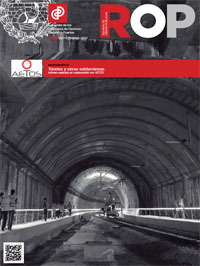
Portada del Número 3590 (Monográfico)

2017 / Número 3590: Túneles y obras subterráneas (Monográfico)
Túneles de Bolaños
Mendaña, Felipe
Felipe Mendaña. Doctor Ingeniero de Caminos, Canales y Puertos. Presidente: SPICC, S.L.
Fuente: 2017, 164 (3590): 46-63
Resumen en español
La construcción de los Túneles gemelos de BOLAÑOS, de 6,7 Km de longitud, de la Línea Ferroviaria de A.V. al Noroeste de España (Galicia) se ha hecho con un escudo simple HK S-805, cuyo diseño se modificó para inyectar bicomponente a presión por el escudo de cola, como relleno del espacio anular (el “gap”) entre terreno y revestimiento. La construcción del TÚNEL DE VÍA DERECHA se inició en Noviembre de 2013, después de una serie de ensayos previos y de la puesta a punto del sistema sobre la propia TBM, montada en la Boca del túnel. Terminado este túnel, con un año de retraso, por causas ajenas al sistema constructivo, a finales de Septiembre de 2015 se inició el TÚNEL DE VÍA IZQUIERDA, que se terminó a mediados de Diciembre de 2016. El artículo se refiere a los dos aspectos principales del Sistema, el primero el tratamiento previo de los múltiples tramos inestables con aplicaciones manuales de resinas órgano-minerales, método perfeccionado en el segundo túnel, que permitió aproximar el ritmo de avance al de los tramos de roca competente. Sobre este aspecto, se exponen: las características del macizo atravesado, constituido por rocas duras y abrasivas fracturadas, consecuengraves y diversas, que van desde caudales de agua significativos, con puntas importantes y presencia errática de finos, hasta frecuentes zonas de falla y, por último, el paso de un importante tramo con riesgo de “squeezing” debido a la presencia de ampelitas en las pizarras. El segundo aspecto destacado en el artículo fue la adaptación del Escudo simple para roca dura, que permitió hacer, con pleno éxito, el relleno por inyección a presión de “bicomponente” del “gap” de cada uno de los anillos. Sobre este particular, el artículo añade las características exigidas al bicomponente, los medios de control de las mismas y las instalaciones específicas montadas en la Obra con las que se consiguió alcanzar dichos objetivos.
Palabras clave:
Escudo simple, escudo de cola, espacio anular, resinas órganominerales, abrasivo, zona de falla, deformación plástica por fluencia
Abstract
The construction of the 6.7 km length BOLAÑOS TWIN TUNNELS, of the new High Speed Railway Line to Galicia (in the North West of Spain) was made with a single type Shield Machine, the HK S—805, that was adapted to fill up the annular void (the gap) between the terrain and the ring by Bicomponent injected under pressure through the tail shield of the TBM. The construction of the RIGHT TRACK TUNNEL started in November 2013 after the accomplishment of a series of previous tests concerning the injection system, which were made again on the TBM once mounted in the R.T. TUNNEL portal. One year after the end of this Tunnel, and due to reasons beyond the construction system, in the end of September 2015 the construction of the LEFT TRACK TUNNEL started, which was completed in the middle of December 2016. The article puts forward the two main points of the construction system. The first of them was the previous treatment of the unstable terrain of the tunnel faces by manual applications of organ— mineral resins. This procedure, that was improved after to be used in the L.T. TUNNEL, allowed the TBM to obtain advance rates near the ones got in competent rock. On this subject, the article explains the main difficulties that were found as: the hard and abrasive fractured rock of the massif, a consequence of the high tectonic phenomena that occurred in the area; the big and several difficulties for the tunnel excavation, as the significant debits of water, with erratic pulling of big amounts of fine particles, or the frequent fault ground sections along the tunnel route, and, in the end, the excavation of a long section under the risk of squeezing, due to the presence of ampelit mineral in the slate formations. The second aspect pointed out in the article was the modification of the hard rock Shield Machine to allow to fill up the annular void (the gap) by bicomponent injection under pressure through the tail shield of the Machine, which was successfully achieved. On this subject, the article relates the technical specifications imposed to the bicomponent; the control measures applied by the Project Management and, in the end, the specific installations of the Contractor, the ones with that, those objectives were accomplished.
Key words:
Shield Machine single type, tail shield, annular void, organic-mineral resin, abrasive, squeezing effect (or else, simply “squeezing”)
1 artículo publicado en esta revista por: Mendaña, Felipe
Túneles de Bolaños
2017, 164 (3590): 46-63
Realización del Colegio de Ingenieros de Caminos, Canales y Puertos con la participación del CINDOC.
Con la colaboración del CEDEX-CEHOPU y la Escuela Técnica Superior de Ingenieros de Caminos, Canales y Puertos de Madrid
© Copyright: Colegio de Ingenieros de Caminos, Canales y Puertos (España)
Propiedad del Colegio de Ingenieros de Caminos, Canales y Puertos (España). Prohibida toda reproducción total o parcial sin citar la fuente.
Property of the Colegio de Ingenieros de Caminos, Canales y Puertos (Spanish Society of spanish engineers). Reproduction by whatever means of the whole or any part of the content is strictly forbidden without reference to source



